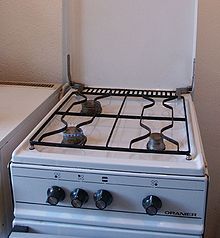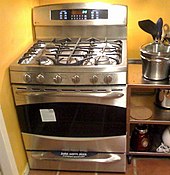Gas stove
A gas stove is a large kitchen appliance (see stove ) that is used to heat food. Gas stoves are available with or without an integrated oven (also heated with gas or electrically).
description
The stove can be supplied with gas from the town gas or natural gas network via a gas socket or with liquid gas from the gas bottle .
During operation, the gas stove generates heat on the one hand, but also causes moisture, since carbon dioxide and water are formed as reaction products of the gas combustion . This effect can be observed particularly well in gas ovens with a viewing window: condensate forms there until the surfaces of the interior have heated up to such an extent that moisture no longer condenses.
Today gas stoves are equipped with a device for flame monitoring, such as a thermocouple . This closes a valve when it cools down and prevents unburned gas from escaping.
Direct gas hobs are extremely economical compared to electric stoves. Some versions have a fully electronic ignition and can reach low temperatures of 75 ° C in the oven by cycling. Since uncontrolled gas ovens cannot provide temperatures below 150 ° C, combination devices with electricity are also common.
A special form of gas stove is the direct burner Chinese stove (or wok stove) in Asian cuisine.
history

As early as 1802, Zachäus Andreas Winzler developed a so-called "thermal lamp". The first gas stoves were developed in the 1820s, but these were mostly isolated experiments. The Englishman James Sharp patented a gas stove in Northampton in 1826 and opened a gas stove manufacturing company in 1836. A gas range was shown at the London World's Fair in 1851, but it was not until the 1880s that the gas range became a commercial success in the United Kingdom.
In Germany, gas stoves also became more prevalent towards the end of the 19th century, especially in cities where gas networks were available for lighting. A gas stove is much easier to operate than a coal stove because the fuel comes from the pipe and no ash needs to be disposed of. The pots on the gas stove also stay clean. In the country, where there was no gas supply but wood was cheap, wood-fired stoves were preferred for a long time. Up until the 1950s, combination stoves were also widespread, in which gas burners were also attached to a stove that was fired with wood or coal. So in winter it was possible to cook on a fire that also heated the kitchen; in summer gas was used instead.
Today in Germany (unlike, for example, France and Italy) electric stoves are more common than gas stoves: In 2014, around 7 percent of households used a stove with a gas hob, while gas ovens were much less common with a share of 4 percent. Without this differentiation, the prevalence of gas stoves in Germany is given as around 6 percent for 2018.
Advantages of the gas stove
- Instant regulation of the heat
- Low energy costs: Depending on the provider, natural gas costs only about a fifth as much as electricity
- Mostly long-lasting, low-maintenance construction
- Mostly more environmentally friendly than electricity
- Inexpensive pots and pans with uneven bottoms and woks can also be used
- Mobile use without power supply
- Greater heat than most electric roasting tubes / ovens
Disadvantages of the gas stove
- Higher risk of explosion, burns and fire compared to electric cookers
- Risk of poisoning if handled improperly
- Temperatures below 150 ° C cannot usually be set in an oven. Braising or keeping warm can only be achieved with electronic ignition and timing.
- Sufficient ventilation of the room is necessary
- With the open design (without glass plate) more difficult cleaning than with the electric stove
Oven temperature overview
| step | 1 | 2 | 3 | 4th | 5 | 6th | 7th | 8th | ||||||||||||||||
|---|---|---|---|---|---|---|---|---|---|---|---|---|---|---|---|---|---|---|---|---|---|---|---|---|
| Temperature in degrees Celsius (reference value) |
140 ° C | 160 ° C | 180 ° C | 200 ° C | 220 ° C | 240 ° C | 260 ° C | 280 ° C | ||||||||||||||||
| Temperature in degrees Fahrenheit (reference value) |
275 ° F | 300 ° F | 325 ° F | 350 ° F | 375 ° F | 400 ° F | 425 ° F | 450 ° F | 475 ° F | 500 ° F | 525 ° F | 550 ° F | ||||||||||||
| Anglo-Saxon level | 1 | 2 | 3 | 4th | 5 | 6th | 7th | 8th | 9 | 10 | 11 | 12 | ||||||||||||
Operation with liquid gas
No official permit is required in Germany for operation with a propane gas cylinder (via a pressure regulator for 50 or 30 mbar) if the stove has an output of less than 11 kW and the room has a volume of more than 20 m³ and is above the ground. An 11 kg gas cylinder may be in the room. For operation with propane gas, the burner nozzles usually have to be replaced, as they are usually equipped for natural gas in the delivery condition. In addition, the bypass screws for liquid gas on the regulators usually have to be screwed in further with a fine screwdriver, otherwise the flame is too big at the lowest position. In order to access the bypass screws, the knobs of some devices have to be removed and the cover dismantled. You can find information on this in the operating instructions under the heading "Setting a small flame".
See also
Web links
Individual evidence
- ↑ The thermal lamp in Germany or:… books.google . Retrieved September 5, 2015.
- ↑ Market data: hobs. HEA - Association for Efficient Energy Use eV, accessed on May 13, 2020 .
- ↑ Market data: stoves and ovens. HEA - Association for Efficient Energy Use eV, accessed on May 13, 2020 .
- ↑ Electricity: 29.2 ct / kWh https://www.strompreise.de/strompreis-kwh/ ; Gas: 5.79 ct / kWh https://www.verivox.de/verbkundenpreisindex-gas/
- ↑ Johanna Bauer: Maintenance at the gas stove. Hausjournal.net, accessed on May 13, 2020 .
- ↑ Oven Temperature. In: onlineconversion.com . Retrieved September 5, 2015.




